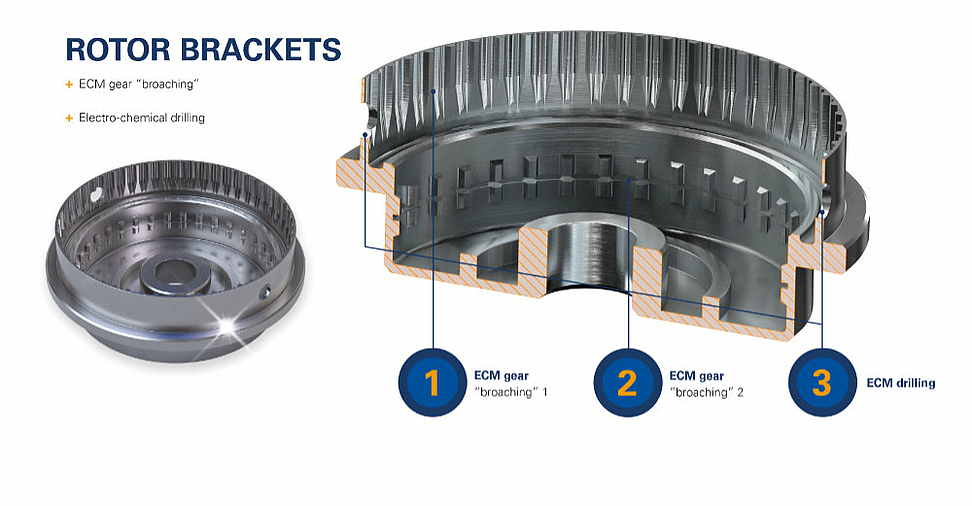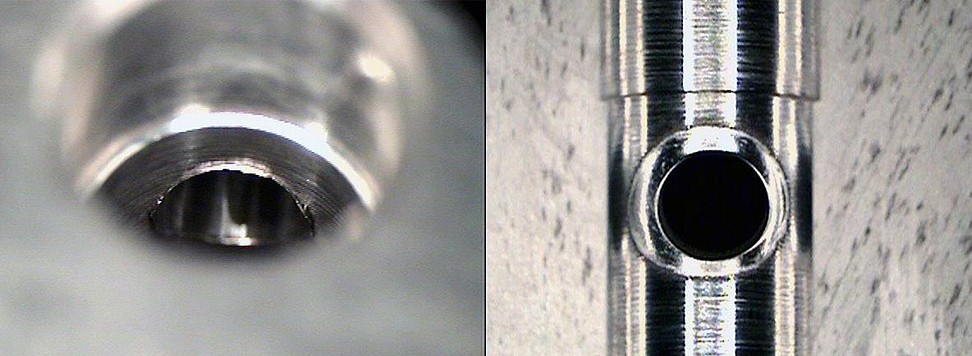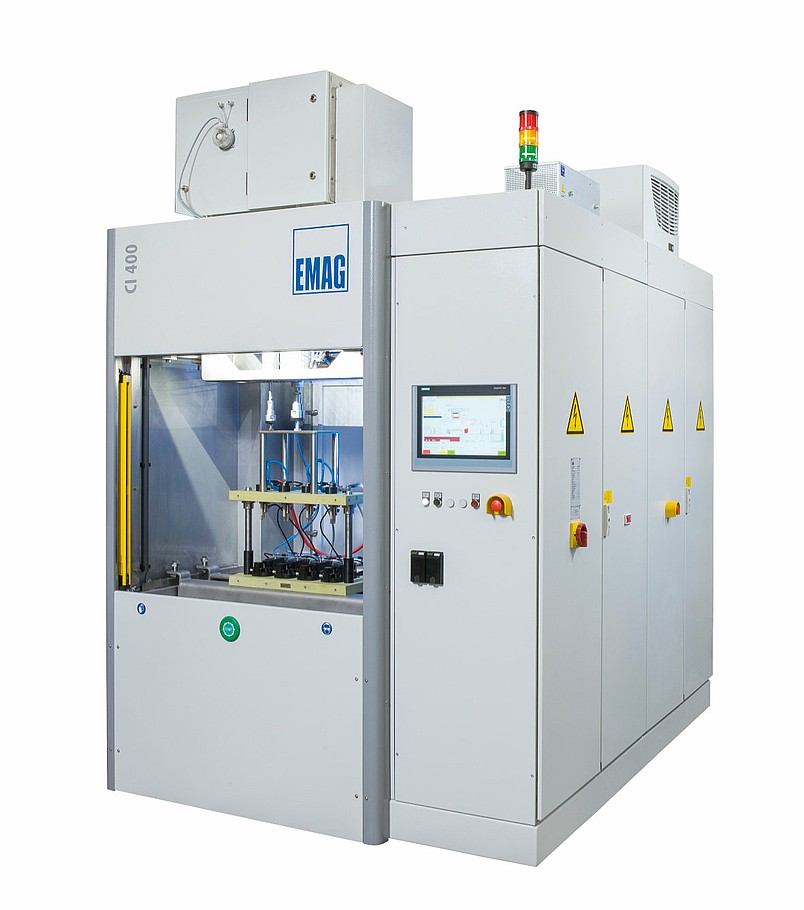Electrochemical metal machining (ECM) is an established technique for burr removal. However, ECM can do much more. The EMAG ECM Company wants to use the process to replace conventional drilling, broaching and even milling. A number of advantages over machining speak in favor of this.

Many components in electric and hybrid motors, such as the rotor arm, also benefit from electrochemical metalworking. The process is faster, more reliable and more energy-efficient than many alternatives.
"Structural change is in full swing and is also affecting the manufacturing industry," Franz Groß, Sales Manager at EMAG ECM in Heubach, is convinced. The advance of electromobility alone will reduce the total number of parts required in the long term. In addition, components would look different in the future. At the same time, the demands on materials, shape, complexity and precision are increasing. For example, more flow-optimized components are being developed based on examples from nature.
One answer to these challenges is electrochemical metal machining (ECM). It can now supplement or even replace conventional machining in many areas - with advantages for quality and economy. According to Groß, "The wear on the tool is much lower than with machining production processes, but the workpiece itself is also protected, since it is not subjected to mechanical and thermal stresses."
The tools are mostly made of the common stainless steels 1.4301 (X5CrNi18-10) or 1.4303 (X5CrNi18-10). On the one hand, they are particularly corrosion-resistant, but on the other hand, they can be machined well and do not need to be hardened. Depending on the material of the workpiece, surface finishes of up to Ra 0.5 micrometers and better are possible. This means that contours, ring channels, grooves or recesses can be produced with maximum precision without contact. "With a clever tool shape, hard-to-reach places can also be machined well and complicated shapes can even be realized inside the component," explains Groß.

A before-and-after comparison: The edge of the bore is absolutely burr-free after ECM machining (right).
Electrolysis forms the basis
ECM uses the physical-chemical process of electrolysis. Franz Groß explains how this works: "Tool and workpiece are in an electrolyte solution. A DC voltage with constant or pulsating current is applied to both. The tool forms the cathode and approaches a workpiece, the anode. A discharge occurs that dislodges material from the workpiece, which is carried away by the electrolyte solution."
Clean electrolyte flows in before each stroke. This is ensured by electrolyte management in a closed circuit. Powerful filters retrieve the removed material from the electrolyte, which is fed back into the process freshly cleaned. Groß: "Depending on the requirements, the electrolyte management forms an integral part in single-station machines or supplies several ECM modules as a separate component." Exchangeable cartridges, comb filter presses or microfiltration with backflushing are available for filtration. Automatic treatment keeps the pH in the neutral range. "The electrolyte should be changed once a year on average," the ECM expert recommends.
Material hardness does not matter
Depending on the machining purpose, different processes can be distinguished: For deburring and rounding of intersections, the use of a stationary tool is suitable. With the moving cathode, the tool moves into the workpiece at a constant feed rate, comparable to drilling and broaching. Precise Electro-Chemical Metal Machining (PECM) is available for three-dimensional machining, in which the tool has a negative shape of the workpiece to be produced. "In the PECM process, an oscillating motion is superimposed on the feed and pulse electronics, which ensures more precise tolerances with a significantly smaller working gap," says Groß.
Franz Groß adds, "Although the tool and workpiece never touch, we achieve feed rates of up to four millimeters per minute when broaching; for very filigree parts, it's still 0.2 millimeters." And this is practically independent of the material, "the only requirement is electrical conductivity." Unlike machining, the hardness of the material plays virtually no role in the process and process duration, he adds. "This also saves process steps because soft machining before hardening can be omitted."
Machines for every need
EMAG's CI and CS type machines are suitable for deburring and drilling. CI stands for Comfort Integrated and refers to machines with integrated electrolyte management. Groß says, "Two CI modules can also be combined to form the CI Duo, both of which then share the integrated electrolyte management system; this enables easy scalability of production capacities as well as entry into automation of the ECM process." CS refers to the standard variant, which is connected to a central electrolyte management system.
Premium Integrated (PI) is a modular machine platform for the PECM process and replaces machining broaching and machining. It is based on the CI with the corresponding compact dimensions. "The entire machine technology with electrolyte management and electrical engineering is accommodated on a basic frame suitable for forklift trucks and requires only 5.5 square meters of floor space," explains Groß.
The modular workspace can accommodate two different modules: the PECM module with oscillator or the ECM lowering module. Both can be used for simultaneous machining of several identical workpieces. Here, too, there is a standard version (PS) for the use of several machines that share a central electrolyte management system.
The machines are controlled by the widely used Siemens Simatik S7-1500 and Sinumerik 840D sl controllers with identical programming. Franz Groß: "For a new workpiece, all that needs to be done is to call up the appropriate stored type program and enter the relevant parameters."
The advantages of the ECM process at a glance
Low tool wear (cathode), thus good prerequisites for series production
Surface quality down to Ra 0.05 micrometer
Precise machining
No thermal and mechanical influence on the components and thus no changes in material properties
Hardness, toughness and magnetic properties are not changed
Production of small and thin-walled contours
Very high repeat accuracy of surface structuring
Simple and highly efficient manufacturing process, no rework such as deburring or polishing necessary
Roughing / finishing / polishing in one operation
Machining of superalloys
Simultaneous machining of macro and micro structures

View of the CI machine from EMAG ECM: Users benefit from extremely compact technology with high-quality components and a favorable price/performance ratio.














